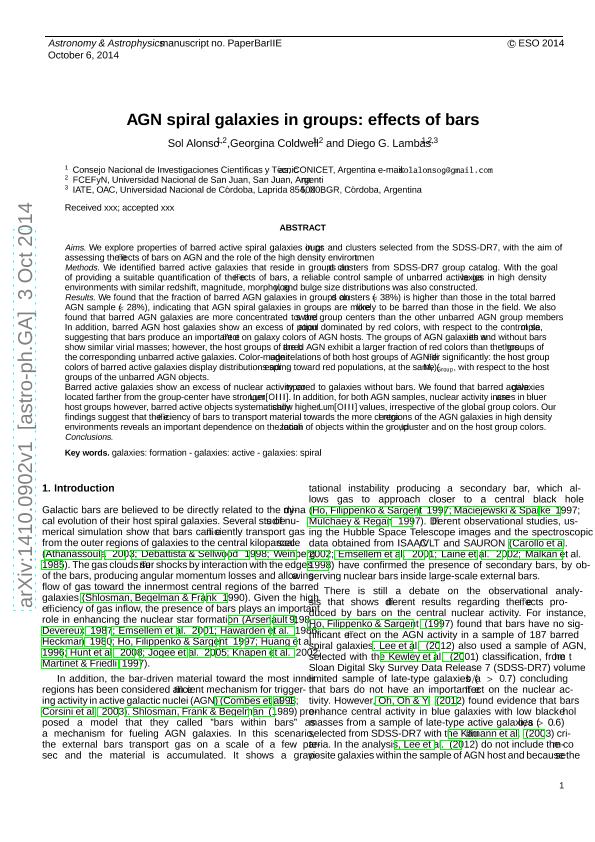Artículo
AGN spiral galaxies in groups: effects of bars
Fecha de publicación:
12/2014
Editorial:
EDP Sciences
Revista:
Astronomy and Astrophysics
ISSN:
0004-6361
e-ISSN:
1432-0746
Idioma:
Inglés
Tipo de recurso:
Artículo publicado
Clasificación temática:
Resumen
AIMS: We explore properties of barred active spiral galaxies in groups and clusters selected from the Sloan Digital Sky Survey data release 7 (SDSS-DR7), with the aim of assessing the effects of bars on active galactic nuclei (AGN) and the role of the high density environment.
METHODS: We identified barred active galaxies that reside in groups and clusters by cross-correlating the total barred AGN sample with the SDSS-DR7 group catalog. With the goal of providing a suitable quantification of the effects of bars, a reliable control sample of unbarred active galaxies in high density environments with similar redshift, magnitude, morphology, and bulge size distributions was also constructed.
RESULTS: We found that the fraction of barred AGN galaxies in groups and clusters (≈38%) is higher than those in the total barred AGN sample (≈28%), indicating that AGN spiral galaxies in groups are more likely to be barred than those in the field. We also found that barred AGN galaxies are more concentrated towards the group centers than the other unbarred AGN group members. In addition, barred AGN host galaxies show an excess of population dominated by red colors, with respect to the control sample, suggesting that bars produce an important effect on galaxy colors of AGN hosts. The groups of AGN galaxies with and without bars show similar virial masses; however, the host groups of the barred AGN exhibit a larger fraction of red colors than the host groups of the corresponding unbarred active galaxies in the control sample. Color-magnitude relations of both host groups of AGN differ significantly: the host group colors of barred active galaxies display distributions spreading toward red populations, at the same (Mr)Group, with respect to the host groups of the unbarred AGN objects. This trend is more significant in less massive groups than in groups with MVirial> 1013.5M⊙. Barred active galaxies show an excess of nuclear activity compared to galaxies without bars in the control sample. We found that barred active galaxies located farther from the group-center have stronger Lum[OIII], while the nuclear activity in AGN galaxies without bars remain approximately constant with the group-centric distance. In addition, for both AGN samples, nuclear activity increases in bluer host groups however, barred active objects systematically show higher Lum[OIII] values, irrespective of the global group colors. Our findings suggest that the efficiency of bars to transport material towards the more central regions of the AGN galaxies in high density environments reveals an important dependence on the localization of objects within the group/cluster and on the host group colors.
Archivos asociados
Licencia
Identificadores
Colecciones
Articulos(IATE)
Articulos de INST.DE ASTRONOMIA TEORICA Y EXPERIMENTAL
Articulos de INST.DE ASTRONOMIA TEORICA Y EXPERIMENTAL
Articulos(SEDE CENTRAL)
Articulos de SEDE CENTRAL
Articulos de SEDE CENTRAL
Citación
Coldwell Lloveras, Georgina Vanesa; Alonso Giraldes, Maria Sol; Garcia Lambas, Diego Rodolfo; AGN spiral galaxies in groups: effects of bars; EDP Sciences; Astronomy and Astrophysics; 572; 12-2014; 1-10
Compartir
Items relacionados
Mostrando titulos relacionados por título, autor y tema.
-
Artículo New quantitative nitrogen abundance estimations in a sample of Seyfert 2 active galactic nucleiDors Jr., O. L.; Arellano Córdova, K. Z.; Cardaci, Monica Viviana ; Hägele, Guillermo Federico (Wiley Blackwell Publishing, Inc, 2017-06)
-
Dors, Oli L.; Agarwal, B.; Hägele, Guillermo Federico ; Cardaci, Monica Viviana ; Rydberg, Claes Erik; Riffel, R. A.; Oliveira, A. S.; Krabbe, A. C. (Wiley Blackwell Publishing, Inc, 2018-09)
-
Carvalho, S.P.; Dors, O. L.; Cardaci, Monica Viviana ; Hägele, Guillermo Federico ; Krabbe, Nora Cristina; Pérez Montero, E.; Monteiro, A.F.; Armah, M.; Freitas Lemes, P. (Wiley Blackwell Publishing, Inc, 2020-06)




